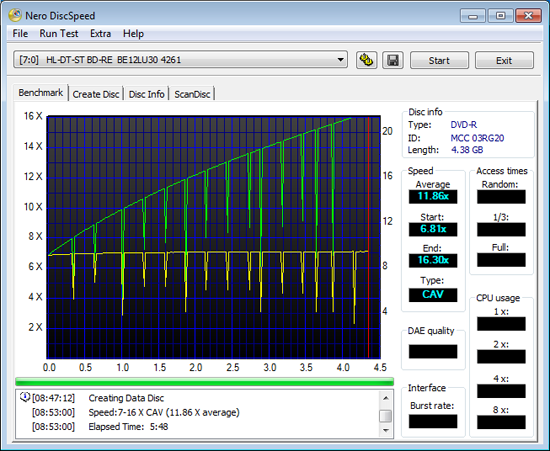Three External USB And eSATA Blu-ray Burners Tested
The advent of affordable, high-capacity media could bring a renaissance in optical storage, but only if the performance is adequate. We tested a few of today’s fastest drives with USB and eSATA connectivity to find out where this technology stands.
DVD-R Single-Layer Write Performance
Our DVD media were rescued from 2009 leftovers, yet Verbatim’s quality shines through by pushing the limits of our drives.
Asus easily reaches the 16x theoretical maximum common to all three of our test drives, averaging 11.68x.
LG trumps Asus this time, with average speed climbs only slightly to 11.87x. Could this be due to its use of eSATA?
Plextor’s USB 3.0 inteface performance falls between that of Asus’s USB 3.0 and LG’s eSATA connection, though we still have another chart to look at before we can call this a win for eSATA.
A second look at LG’s performance, this time using USB 2.0, proves that it’s the drive, rather than the interface, responsible for the unit’s slightly better performance. DVD speeds have a far lower corresponding data rate than Blu-ray, but latency could have been an issue.
Plextor gains nothing in the change from USB 3.0 to eSATA.
Get Tom's Hardware's best news and in-depth reviews, straight to your inbox.
Current page: DVD-R Single-Layer Write Performance
Prev Page BD-R Dual-Layer Write Performance Next Page DVD+R Dual-Layer Write Performance-
Crashman pirateboyno LiteOn device? why?The eHBU212 wasn't available yet when this roundup was initiated last spring. Sorry, other reviews had deadlines.Reply -
Could you please add a chart about the quality of the burned data itself.Reply
(I do not know if this is possible?) A lot of people still burn audio CDs and for this the burn quality is normally essential -
Crashman Mille23Could you please add a chart about the quality of the burned data itself.(I do not know if this is possible?) A lot of people still burn audio CDs and for this the burn quality is normally essentialIt's in the photo album:Reply
http://www.tomshardware.com/gallery/bd-sl-scan-ASUS,0101-302721-9789-0-0-0-jpg-.html See no errors know no errors. -
Crashman dimarWhen do we finally get eSATAp?It's been replaced with USB 3.0, and neither of those has enough amperage to power these drives.Reply -
dimar CrashmanIt's been replaced with USB 3.0, and neither of those has enough amperage to power these drives.Reply
Not true. http://en.wikipedia.org/wiki/ESATAp
I already have the bracket for eSATAp where I have the power supply connected using the 12v/5v molex cable. -
Crashman dimarNot true. http://en.wikipedia.org/wiki/ESATApI already have the bracket for eSATAp where I have the power supply connected using the 12v/5v molex cable.That's fine, but it doesn't contradict what I said.Reply
Let me be more specific: USB 3.0 is primarily for portable devices, eSATA is primarily for stationary devices, and eSATAp is something in the middle that doesn't have enough power for "big" drives such as these.
The purpose of eSATAp WAS to combine the convenience of USB 2.0 with the performance of eSATA. But the purpose of USB 3.0 IS to combine the convenience of USB 2.0 with the performance of PCIe. This is a was vs is debate, Windows XP is still great too but many people have simply quit using it.
Hey, I remember external SCSI too!
BTW, some of these drives DO support eSATA. Forget the P, a USB power connector won't power these drives! -
dimar CrashmaneSATAp is something in the middle that doesn't have enough power for "big" drives such as these.Reply
You don't get it. You actually connect the power supply power cable to the back side of the eSATAp connector. It gets the full 12v and 5v load.





